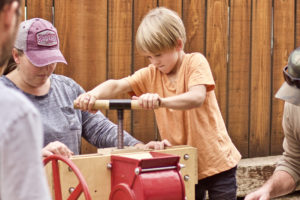A family festival held 15 years ago at The Mountain School in Bellevue was a ceremonial homage to the seasons and nature’s bounty. It was alive with costumes, performances, dancing, music, and intoxicating merriment that felt like a step back in time to the Renaissance era—when celebrations were sacred and treasured. What was this captivating place?
It was a Waldorf school.
Often misunderstood in North America, Waldorf education is an approach that recognizes the needs of the whole child as he or she develops his interconnected mind, body and spirit. As Mary Goral writes in “Transformational Teaching,” it fosters intellect through “story, parable, and myth.” Children build skills and intelligence through hands-on tasks, creating art, and experiences in nature. In early years, children grow in confidence, wonder and voice; later, the narrative and creative tasks shift into reading, writing, math, the sciences, active imagination and problem solving.
In the Waldorf tradition of storytelling—a fundamental concept to invoke language development, memory and expression—the following narrative describes how the work of play and learning-by-doing taught a young boy to read.
Like all children, James was born to read. In infancy he imitated gestures, organized symbols and repeated sounds. At 3, he entered Sweet Clover School, a Waldorf preschool in Hailey, where routine and rhythm diverted his wild energy into intuitive activity. It was an ebb and flow of storytelling, outdoor exploration, cooking, singing, painting and creating. Neither he nor his parents knew it, but he was preparing to read by exploring the world through his senses. Colors and textures were beguiling; natural aromas were fresh and inviting; sounds of wood toys knocking, the chopping of vegetables, and tiny toddler voices reciting songs filled the school.
In kindergarten, James entered Syringa Mountain School, a public charter founded on traditional Waldorf ideals that also adheres to required common standards. His parents wondered how this nontraditional unfolding of experiential learning would translate into academia. The methods were unfamiliar. The teachers were inspiringly dedicated to Waldorf concepts, and their students flourished. There was trust in the process that timing is everything, and everything is strategic.

Students at Syringa Mountain School experiment with creative writing and running an apple press.
Early care Waldorf methodology guided James into rich experiences in which bodily skills were transformed through nature, art, song, and movement. James began to see letters by painting vibrant images, lines, and curves with a tactile wooden brush; these gestures would eventually become letters. He explored books of adventure, and learned traditional verses in rhythm and rhyme.
In first grade, emphasis was placed on a deep and potent organization of letters captured in the spoken word, song, play, and craft. Letters were presented to James in lively pictures that told stories and appealed to his imagination. For example, the letter “S” was a fairy tale snake sinuously slithering through the grass on some secret errand. On the chalkboard, his teacher depicted the letter “W” embedded in an image, hidden in the waves. James drew letters in the air with his hands and on the floor with his feet. He immersed his entire being in the phonetic, visual, and physical experience of learning the 26 symbols that make up the alphabet. Letters became meaningful. They were not just memorized; they were embodied.
James began noticing letters everywhere; he pointed, sounded, and asked what they symbolized. He cultivated his own relationship with the human alphabet by reading the natural world in the forms of landscapes, water and weather, plant and animal life, color and form, and rich interaction in festival life. His word recognition seemed to hatch overnight, yet it was carefully cultivated, and taught out of order.
The foundation was set for James to blossom on an innate pathway toward cognitive learning. By the third grade, his reading and writing skills flourished and his zest for creative expansion was evident.
According to Dr. Rudolf Steiner, an Austrian philosopher, playwright, artist, and literary critic who created much of the foundation of the Waldorf method, children should be taught based on developmental stages of growth that shift approximately every seven years. During early childhood, a child learns through senses, absorbed patterns, rhythms, and impersonations that create an inner and outward foundation for his individuality. Around 7, the brain connects the rational with the emotional. The child leaves dreamy early childhood and shifts into a more conscious state. Feelings and imagination develop, and he becomes aware of himself as an individual.
Subsequent years bring forth increased stability and independence. Around 14, intellectual consciousness abounds, and deeper concepts of the world, humans and phenomena are examined and understood.
This educational system relies on the inherent learning abilities of children through the phases of their changing bodies and brains. Intelligence unfolds as naturally as the movement of the seasons. Students go on to excel at math, music, science, writing and reading. They become proficient in the humanities—music, acting, art and handwork—a place to focus their left-brain activities. They also foster an unmistakable connection with nature, community, their inner character, and humankind. This is the remarkable work of Waldorf: to cultivate, as Goral writes, “head, hand, and heart.”


